Tomatoes are one of the most popular vegetables grown in home gardens. This is probably due to their wide range of uses from salads to curries, and everything in between.
Growing tomatoes isn’t hard, but they can be rather fussy vegetable plants. Tomato plants will be happy and productive as long as they have the proper growing conditions and receive good care and maintenance.
In this post, we are going to go through all that you need to know to start growing healthy tomatoes.
Choosing the right location
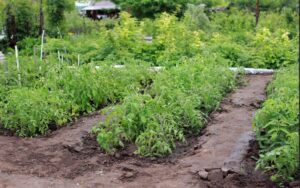
Tomato plants are warm-season vegetable that needs at least 6 to 8 hours of sunlight each day and isn’t frost tolerant at all. This basic condition must always be met.
Tomatoes can be grown in raised beds or directly in the ground, and are also excellent candidates for container gardening. Discover which kind of vegetable garden is best for you.
Tomatoes prefer slightly acidic to neutral soil with a pH of 5.5-7.0 and need well-drained soil to grow strong roots that are disease-free. You can add acidic organic amendments to your soil to reduce its alkalinity if needed. Before planting, you can add compost or well-rotted manure to the soil to improve its texture, pH balance, and nutrient release.
Varieties of tomatoes to grow
Due to their popularity worldwide, there are now numerous varieties of tomatoes available. Choosing the right variety for your needs will help you get a better harvest.
Varieties of tomatoes that have been bred specifically for your local climate would be best. Some varieties are more disease- or nutrient-deficiency-resistant. Other varieties have been specially bred to be grown in containers. Similarly, some varieties are better suited for fresh use, while others are more suited for canning.
Starting your tomato plants
Tomato plants grow best when seedlings are transplanted into the garden. This also makes it possible to start your tomato plants from seeds indoors before it’s warm enough to bring them outdoors. Alternatively, you can buy tomato seedlings from a nursery and transplant them into your garden. Read this comparison between starting from seeds or transplants to decide what’s best for you.
Tomato seeds need a minimum soil temperature of 10°C to germinate, but germination is very slow at this temperature and can take over 40 days. On the other hand, if the soil temperature is higher than 35°C, tomato seeds will not even begin to sprout. 25-30°C is the ideal soil temperature for tomato seed germination. Germination will occur in just 6–8 days at this ideal soil temperature.
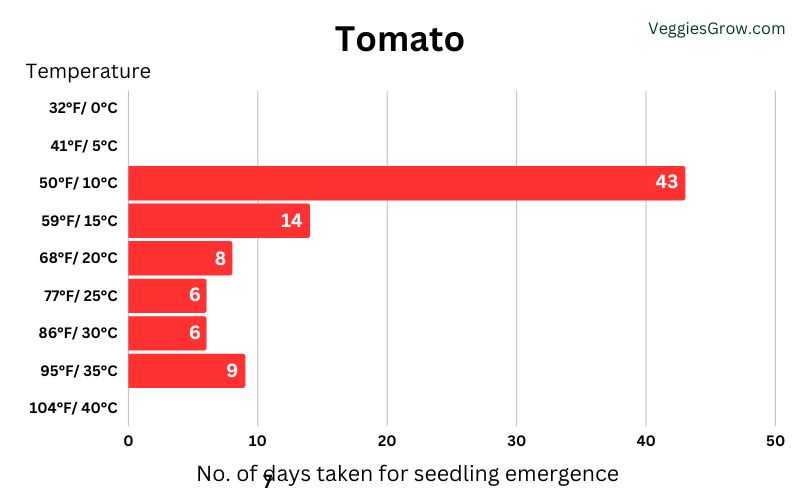
You can start your tomato seeds in seed-starting trays or pots. 2-4 tomato seeds can be added to each tray section or pot. Once the seeds start to sprout, you can thin the seedlings to one seedling per tray section or pot.
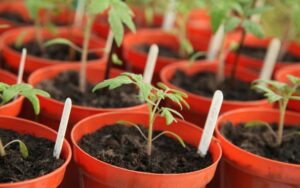
Tomato plants shouldn’t be older than 8 weeks when transplanted. When seedlings aren’t transplanted soon enough, they can become root-bound, unhealthy, and easily affected by pests and diseases. For this reason, you should find out when your area would be warm enough to transplant the seedlings, as given below, and then work backward to find the best date to start your seeds.
You can find step-by-step instructions on finding the best date to start your vegetable seeds here.
Transplanting tomato seedlings
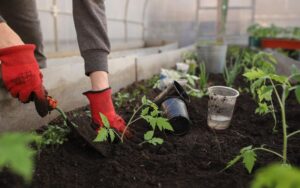
The seedlings will be ready for transplanting when they are 6-8 weeks old, about 3-4 inches tall, and have at least developed their first set of true leaves (second set of leaves).
Before transplanting, you’ll need to make sure that the ground is frost free and at a temperature of between 61°F (16°C) and 70°F (21°C). Air temperatures of 77°F (25°C) – 86°F (30°C) during the day and 61°F (16°C) – 68°F (20°C) at night are best for growth.
Tomato plants can grow roots from their stems. This means that when transplanting, you can bury the stem of the tomato plant a few inches lower than the soil level to encourage stronger root growth. Before transplanting, you should remove all leaves on the area of the stem that would be under the ground.
Growing tomatoes in containers
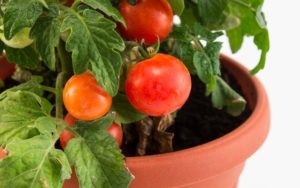
Tomatoes are ideal for container gardens, which allow you to grow tomatoes even if you don’t have actual garden space but only a balcony, terrace, or built-up area.
Although tomato plants are rather slender, they have large roots that need a lot of space to grow. A container that is at least 18 inches wide and 24 inches deep would be best. Smaller varieties of tomatoes, such as cherry tomatoes, can grow in containers that are both 12 inches wide and deep.
Like for almost all types of vegetables, you should make sure that the container has a few drainage holes so that the roots aren’t waterlogged after being watered. If you live in an area that gets heavy rain, you should keep your containers in a partially covered area or be able to move your tomato plants to a sheltered area during heavy rains. Tomato roots that are left damp for too long develop root rot and many other root diseases.
You shouldn’t use garden soil for containers. Instead, you’ll need to purchase potting soil and add extra compost or create your own container mix. Coco peat is ideal for containers because it’s lightweight but it doesn’t contain any nutrients, so you’ll have to add about 1/3 compost to 2/3 coco peat. Other organic amendments, such as gypsum, crushed eggshells, and bone meal, can also be added.
The frequency of watering tomato plants in containers is different from those grown on the ground or in raised beds and is detailed under watering. Despite this, other care and maintenance steps are pretty much the same.
More information specific to starting a container vegetable garden
Provide support for your tomato plants
Tomato plants will need some support as they grow to keep them upright. You can use stakes, cages, or trellises to keep the plants off the ground and prevent the fruit from touching the soil.
Keeping your tomato plants upright also prevents the branches from bunching together, which can create damp, dark areas that encourage pest growth.
Watering your tomato plants
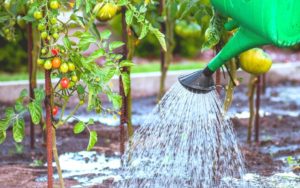
Tomato plants need consistent moisture, so plants grown directly in the ground will need to be deeply watered once a week or more often during hot weather. Tomato plants grown in containers need to be watered at least once a day but may need watering twice a day during warm weather.
Tomato plants should be watered close to the base of the plant to avoid water touching the leaves for preventing fungal diseases.
Extra care needs to be taken with watering while tomato plants are flowering and fruiting, as inconsistencies in watering during this period can severely affect your harvest.
Fertilizing your tomato plants
Tomato plants are heavy feeders that need to be fertilized regularly. Fertilizing at least once in two weeks, especially during flowering and fruiting, is ideal. Compost is an ideal fertilizer for tomato plants since it releases balanced amounts of nutrients slowly.
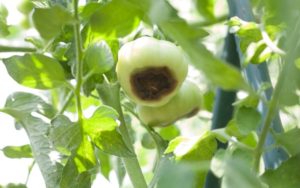
Tomato plants grown in containers are easily affected by blossom-end-rot, which is caused by calcium deficiency but can also be induced by poor watering, rather than insufficient calcium in the soil. Although egg shells are commonly recommended for increasing the calcium content in the soil of home gardens, egg shells decompose very slowly and need to be powdered before they are added to the soil. A richer source of calcium, such as gypsum, is a better alternative to increase the calcium available in the soil within a shorter period of time. More information on calcium deficiency in vegetable plants and what to do
Tomatoes also need enough phosphorus for healthy flowering and fruit set. Animal manure, bone meal, and rock phosphate are ideal sources of organic phosphorus that can be added.
Tomato flowers and fruit set
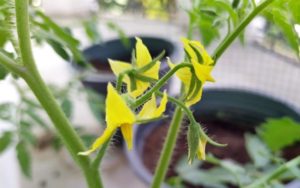
Tomato flowers contain both male and female parts and can be self-fertilized. Regardless, they benefit from bees and other pollinators, who can increase the number of tomatoes and their quality.
Blossom drop is also a common problem in tomatoes, where the flowers drop before being fertilized. High temperatures or a lack of pollinators are usually the causes. Fruit set is best at temperatures of 65–80°F (18.5 – 26.5°C). Fertilization of tomato flowers can also be affected by humidity, infrequent watering, a lack of nitrogen, diseases, or simply because the plant won’t be able to support more tomatoes.
Container-grown tomatoes are easily affected by a lack of pollinators. To encourage pollinators, you can grow more flowering plants, like marigolds and sunflowers, near your tomato plants. Alternatively, you can vigorously but gently shake your tomato plant branches once the flowers have opened to encourage self-pollination.
It goes without saying that fruit set is optimal when tomato flowers are well fertilized.
Tomato pests and diseases
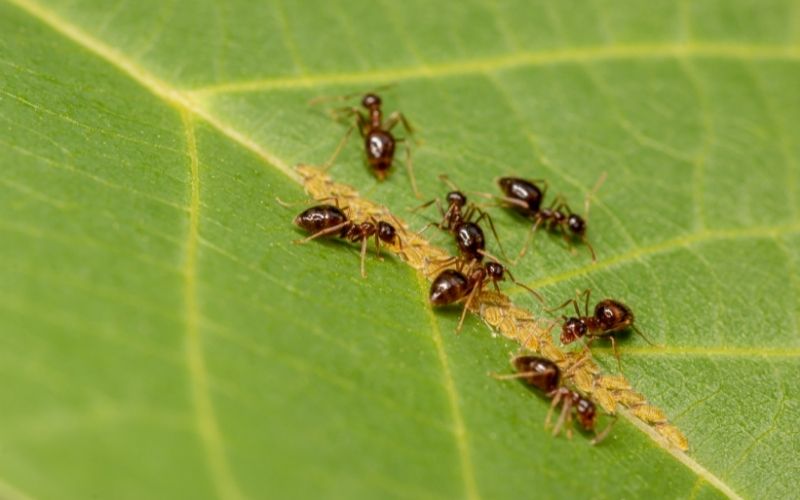

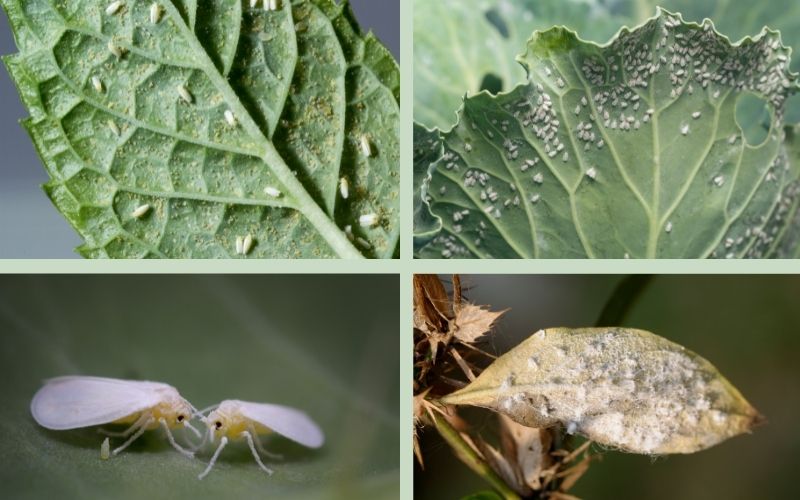
Tomato plants are commonly affected by aphids, whiteflies, mealybugs, and tomato hornworms, and are easily affected by diseases like early blight, late blight, and powdery mildew.

Tomato plants should be observed regularly so that you can catch the first signs of these pests and diseases to reduce or eliminate risks. In addition, keeping tomato plants well-watered but dry, as well as upright, can discourage pests and diseases by eliminating the damp and dark conditions that they need to thrive.
Encouraging beneficial insects, like ladybug beetles, that prey on pests can help you easily and naturally control pests.

Now you know all that you need to know to give the best start to your tomato plants and take care of them so that you can get the best harvest of tomatoes possible!



Thank you for these tomato growing tips! I agree that supporting the plant is so important. One year, I didn’t support my plants and just let them lay on the ground and I lost so much of the fruit because it was touching the ground. Rot and insects got the best of it. Now I always grow my tomatoes off the ground…lesson learned!
Thank you for sharing your experience! Nothing like learning through mistakes